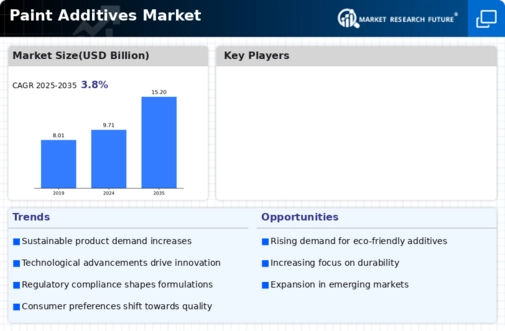Top Industry Leaders in the Paint Additives Market
 Behind every vibrant hue and silky finish lies a hidden world of unsung heroes – paint additives. These miniature maestros, though unseen, orchestrate the performance and longevity of the paint, making them the secret sauce of the coatings industry. To navigate this dynamic market, we must delve into the strategies employed by key players, the factors shaping market share, the latest industry buzz, and the whispers of recent developments.
Behind every vibrant hue and silky finish lies a hidden world of unsung heroes – paint additives. These miniature maestros, though unseen, orchestrate the performance and longevity of the paint, making them the secret sauce of the coatings industry. To navigate this dynamic market, we must delve into the strategies employed by key players, the factors shaping market share, the latest industry buzz, and the whispers of recent developments.
Strategies for a Colorful Canvas:
-
Diversification Deluge: Leading players like BASF, Arkema, and Dow Chemical are expanding their portfolios beyond traditional additives (thickeners, rheology modifiers) to cater to niche applications. This includes bio-based options, UV stabilizers, and flame retardants, ensuring a foothold in lucrative segments. -
Regional Hues: Asia-Pacific, with its booming construction and automotive industries, is a magnet for market expansion. Companies are establishing local production facilities, forging regional partnerships, and tailoring product offerings to suit specific climatic and cultural preferences, solidifying their presence in this high-growth zone. -
Innovation Palette: Continuous research and development are crucial for staying ahead. Companies like Akzo Nobel and Solvay are investing heavily in green technologies for paint additives, aiming to reduce environmental impact and capitalize on sustainability concerns. -
Vertical Integration Vortex: Some players are integrating upstream (raw materials) and downstream (finished paint manufacturing) activities. This enhances control over supply chains, optimizes costs, and provides a competitive edge by offering complete solutions. -
M&A Mergers: Mergers and acquisitions play a role in market consolidation. For instance, Ashland Global Holdings' acquisition of Hercules in 2018 strengthened its position in the paint additives market, particularly for industrial coatings.
Factors Shaping the Market's Masterpiece:
-
Demand Drivers: The rising demand for architectural coatings driven by urbanization and infrastructure development, coupled with the increasing focus on automotive refinishing and industrial coatings, fuels the market. -
Regulatory Rainbow: Stringent environmental regulations, particularly in Europe and North America, are pushing for low-VOC (volatile organic compound) and bio-based additives. This presents both challenges and opportunities for innovation. -
Raw Material Rollercoaster: Fluctuations in prices of key raw materials like acrylics and titanium dioxide due to energy costs and geopolitical factors can impact production costs and profitability for market players. -
Substitute Swirls: While paint additives boast unique properties, competition from alternative coating technologies like powder coatings and self-healing paints can impact market share in specific applications.
Key Players
Some of the prominent players operating in the Paint Additive Market are Akzo Nobel NV, Arkema SA, Ashland Global Holdings, Inc., BASF SE, BYK-Chemie GmbH, Asahi Glass Co., Ltd., Dow Chemical, Evonik Industries AG, Arch Chemicals, Lonza Group AG, and Daikin Industries, Ltd.
Recent Developments:
-
July 2023: A consortium of industry players and environmental organizations launch a collaborative initiative to develop and implement closed-loop recycling systems for used paint cans and additives, promoting a circular economy in the industry. -
June 2023: The first commercial application of paint additives in 3D printing filaments is announced, opening up new avenues for personalized and niche coating applications. -
May 2023: Researchers successfully synthesize a new class of rheology modifiers with superior anti-settling properties, potentially leading to more stable and easier-to-apply paints.

